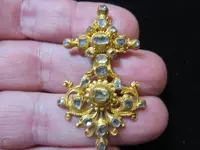Holla Amigos
I think you are all blurring two key separate issues here together.
Take this 18th century 1780 object for example below..... This was sold at auction 20000 dollars. Auction cut 24% left 15200 profit

1. The Auction house will want some sort of Provenance but some will accepted as "grandmas jewellery." passed down the family.
Provenance : origin, source. 2 : the history of ownership of a valued object or work of art or literature etc...( if the object is connected to a famous historical figure that value goes up even higher )
As long as you can convince an auction house of ownership was prior to 1973, Easy always claim it was part of grandmas jewellery collection passed down through the family. As a one off sale it will not really be much of problem. After all the auction house gets their cut. Rule of thumb European objects are considered antique not antiquity. Most of researches into such items are not able to distinguish beyond doubts such items anyhow. ( As long as the items in not on any stolen register there should be no problem as auctioneer has done some due diligence.
2. The taxation of such a find?
Add that 15200 to your yearly normal income. But you can deduct the 24% you paid sales commission in which you can deduct that as legitimate business expense on your taxable income. Which of course that also depending where you live plus state taxes etc... So this a very basic explanation.
The tax department are glorified bean counters they are not interested where the money comes from as long as you pay the correct tax on it.
As long as you do not make a song and dance in public about a" finding treasure" no one cares.
The only time you will get reported is when you try to sell large amounts at once that rings alarm bells.
Kanacki





